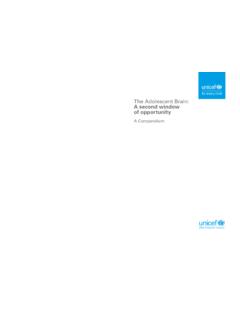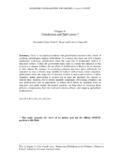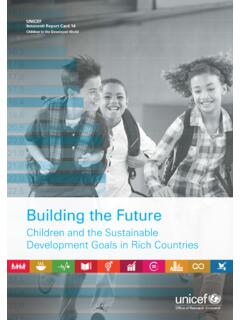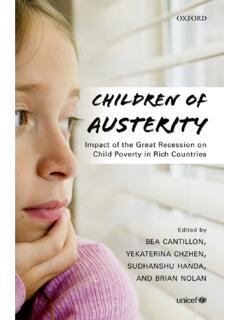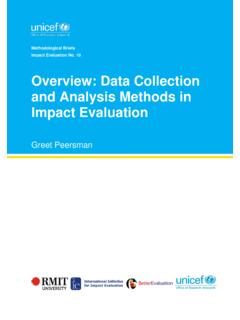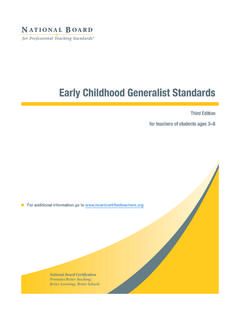Transcription of “We may be unnecessarily sabotaging our present, and our ...
1 We may be unnecessarily sabotaging our present, and our children's future, by being blind to the inconsistencies and irrationalities of adult-child interaction in family and community in this century. Mass media programmes about the right to a happy and secure childhood and to a happy and secure retirement cannot substitute for the actual experience of frank and honest confrontation between generations when perceptions, needs and interests differ, in a context of mutual acceptance of responsibility for each other.
2 Neither can special feed- ing, health and education programmes undertaken for children sub- stitute for joint community projects carried out by adults and children together, in which capacities of the young to contribute to the welfare of all receives full recognition.. Elise Boulding, Children's Rights and the Wheel of Life, New Brunswick, NJ, USA, 1979, p. 89. Graphics layout: S. Selim Iltus The opinions expressed are those of the author and do not necessarily re ect the policies or views of UNICEF. Copyright 1992.
3 UNICEF International Child Development Centre Spedale degli lnnocenti Florence, Italy ISSN: 1014-7829. ISBN: 88-85401-05-8. March 1992. CHILDREN'S PARTICIPATION: FROM TOKENISM TO CITIZENSHIP. by Roger Hart UNICEF / FRAN ANTMANN. A demonstration by school children in Peru for immunization 1. CONTENTS. 3. I. 4. II. THE MEANING OF CHILDREN'S 5. III. MANIPULATION AND TOKENISM: MODELS OF. 9. IV. MODELS OF GENUINE 11. V. RESEARCH WITH 15. VI. PLAY AND WORK: THE DIFFERENT REALITIES IN. INDUSTRIALIZED AND DEVELOPING 20.
4 VII. CHILDREN IN ESPECIALLY DIFFICULT. 24. VIII. FACTORS AFFECTING CHILDREN'S ABILITY. TO 31. IX. THE BENEFITS OF 34. X. WHERE TO 37. REFERENCES AND FURTHER 38. 2. PREFACE. In 1979 the US section of the International Playground Association (IPA, now renamed the International Associa- tion for the Child's Right to Play) recommended that their contribution to the International Year of the Child would be to further the status of young people's participation in environmental projects. Together with Robin Moore and a small team of graduate students and teenagers, I mounted an international survey on the subject and three special issues of the Childhood City Newsletter were published.
5 Regrettably, we received very little information on the many good examples of children's participation from the developing nations. But UNICEF, with its long term commitment to adult community participation has corrected the problem by commissioning this Essay. As part of its research on street and working children, the Urban Child Programme of the UNICEF International Child Development Centre (ICDC) arranged for me to travel to Kenya, India, the Philippines, and Brazil. I visited both projects with street children and preventive programmes for children at risk of becoming street children.
6 I discovered that, for a number of countries, children's participation is becoming fundamental to their approach to improving children's rights. This is truly an area for the valuable exchange of experiences between nations of the North' and the South'. The International Child Development Centre of UNICEF in Florence, Italy has been a superb base for writing about this subject. I am most grateful for the strong support throughout of Cristina Blanc, Senior Programme Of cer for the Urban Child Programme, who commissioned this Essay.
7 Also, Jim Himes, the Director of ICDC generously provided creative insights and detailed commentaries. In addition, I received valuable commentary from Savitri Goonesekere, Maalfrid Flekk y, and Jason Schwartzman. Sandra Fanfani and Kathy Wyper were supremely competent and supportive in a host of practical ways in getting this Essay out: professionals with a valuable sense of humour. A number of people at the UNICEF headquarters in New York have also been very encouraging. As the UNICEF. senior policy advisor responsible for community participation in 1982, Mary Racelis rst revealed to me that there might be an audience for my ideas on children's participation.
8 Together with John Donohue, who was then the UNICEF advisor on urban affairs, she helped me a great deal by introducing me to community development issues beyond the USA and Europe. More recently, Marjorie Newman-Black, Historian/Editor and Per Miljeteig-Olssen, Public Affairs Of cer offered valuable assistance. My partners in the Children's Environments Research Group staff were hard working and exible as always: Se- lim Iltus with his extraordinary mix of intellectual talent and artistic and graphic layout skills, Ann Kelly for copy editing, and Lisa Price and Elizabeth Wilson for word processing.
9 I dare not try to recognize all of the wonderful people devoted to disadvantaged children I met overseas. I hope they will be satis ed by seeing in this Essay the in uence of their ideas, and of the projects I saw. My guiding hosts in these countries were: Monica Mutuku and Viki Kioko in Kenya; Rita Panicker and Gerry Pinto in India; Pol Moselina, Jimmy Tan, Ana Dionela, Sony Chin, and Emma Porio in the Philippines; and Mario Ferrari, Lidia Galeano, Neusa Lima, and Bill Myers in Brazil. Martinha Arruda, who provided simultaneous translation during three weeks of grueling sched- ules in eight cities of Brazil, was heroic.
10 Outside of UNICEF a number of my colleagues generously critiqued the text: Joe Benjamin, youth worker and a pioneer of the adventure playground movement in Britain; Richard Chase, President of the Child Growth and Develop- ment Corporation; William Cousins, development consultant and former UNICEF senior policy specialist in urban affairs;. Fabio Dallape, expert on East African Programmes for Street and Working Children; William Kornblum, sociologist; Da- vid Kritt, developmental psychologist; Geraldine Laybourne, President of Nickelodeon Television; Robert Schrank, expert on the world of work; and Brian Waddel, political scientist.

